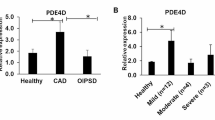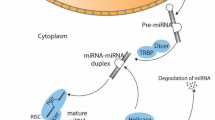Abstract
Herein, miRNA candidates relevant to mycosis fungoides were investigated to provide data on the molecular mechanisms underlying the pathogenesis of the disease. The miRNA expression profile of skin biopsies from patients with tumor stage MF (tMF) and normal donors was compared using miRNA microarrays. Overall, 154 miRNAs were found differentially expressed between tMF and the control cohort with the majority of them being up-regulated (57 %). Among the upregulated miRNAs, miR-3177, miR-514b-3p, miR-1267, and miR-1282 were exclusively detected in 70 % of tMF. Additional upregulated miRNAs included miR-34a, miR-29a, let-7a*, and miR-210, while miR-200c* was identified among the downregulated ones. Quantitative real-time polymerase chain reaction was used to further investigate the expression profiles of miR-34a and miR-29a and validated the overexpression of miR-34a. Enrichment studies revealed that the target genes of the differentially expressed miRNAs were important in several cancer-related signaling pathways. The overlapping relationship of the target genes among tMF, Sezary syndrome, and atopic dermatitis revealed several common and disease-specific genes. Collectively, our study modulated miR-34a as a candidate oncogenic molecule and miR-29a as a putative tumor suppressor highlighting their promising potential in the molecular pathogenesis of tMF.




Similar content being viewed by others
References
Olsen E, Vonderheid E, Pimpinelli N, Willemze R, Kim Y, Knobler R, et al. Revisions to the staging and classification of mycosis fungoides and Sezary syndrome: a proposal of the International Society for Cutaneous Lymphomas (ISCL) and the cutaneous lymphoma task force of the European Organization of Research and Treatment of cancer (EORTC. Blood. 2007;110(6):1713–22. doi:10.1182/blood-2007-03-055749.
Kim YH. Management with topical nitrogen mustard in mycosis fungoides. Dermatol Ther. 2003;16(4):288–98.
Scarisbrick JJ, Prince HM, Vermeer MH, Quaglino P, Horwitz S, Porcu P, et al. Cutaneous lymphoma international consortium study of outcome in advanced stages of mycosis fungoides and Sezary syndrome: effect of specific prognostic markers on survival and development of a prognostic model. J Clin Oncol. 2015;33(32):3766–73. doi:10.1200/JCO.2015.61.7142.
Braoudaki M, Lambrou GI, Giannikou K, Papadodima SA, Lykoudi A, Stefanaki K, et al. miR-15a and miR-24-1 as putative prognostic microRNA signatures for pediatric pilocytic astrocytomas and ependymomas. Tumour Biol. 2016. doi:10.1007/s13277-016-4903-7.
Braoudaki M, Lambrou GI, Giannikou K, Milionis V, Stefanaki K, Birks DK, et al. Microrna expression signatures predict patient progression and disease outcome in pediatric embryonal central nervous system neoplasms. J Hematol Oncol. 2014;7:96. doi:10.1186/s13045-014-0096-y.
Braoudaki M, Lambrou GI. MicroRNAs in pediatric central nervous system embryonal neoplasms: the known unknown. J Hematol Oncol. 2015;8:6. doi:10.1186/s13045-014-0101-5.
van Kester MS, Ballabio E, Benner MF, Chen XH, Saunders NJ, van der Fits L, et al. miRNA expression profiling of mycosis fungoides. Mol Oncol. 2011;5(3):273–80. doi:10.1016/j.molonc.2011.02.003.
Sandoval J, Diaz-Lagares A, Salgado R, Servitje O, Climent F, Ortiz-Romero PL, et al. MicroRNA expression profiling and DNA methylation signature for deregulated microRNA in cutaneous T-cell lymphoma. J Invest Dermatol. 2015;135(4):1128–37. doi:10.1038/jid.2014.487.
Vlachos IS, Kostoulas N, Vergoulis T, Georgakilas G, Reczko M, Maragkakis M, et al. DIANA miRPath v.2.0: investigating the combinatorial effect of microRNAs in pathways. Nucleic Acids Res. 2012;40(Web Server issue):W498–504. doi:10.1093/nar/gks494.
Paraskevopoulou MD, Georgakilas G, Kostoulas N, Vlachos IS, Vergoulis T, Reczko M, et al. DIANA-microT web server v5.0: service integration into miRNA functional analysis workflows. Nucleic Acids Res. 2013;41(Web Server issue):W169–73. doi:10.1093/nar/gkt393.
Wang J, Duncan D, Shi Z, Zhang B. WEB-based GEne SeT AnaLysis toolkit (WebGestalt): update 2013. Nucleic Acids Res. 2013;41(Web Server issue):W77–83. doi:10.1093/nar/gkt439.
Marosvari D, Teglasi V, Csala I, Marschalko M, Bodor C, Timar B, et al. Altered microRNA expression in folliculotropic and transformed mycosis fungoides. Pathol Oncol Res. 2015;21(3):821–5. doi:10.1007/s12253-015-9897-8.
Gallardo F, Sandoval J, Diaz-Lagares A, Garcia R, D’Altri T, Gonzalez J, et al. Notch1 pathway activation results from the epigenetic abrogation of notch-related MicroRNAs in mycosis fungoides. J Invest Dermatol. 2015;135(12):3144–52. doi:10.1038/jid.2015.328.
Maj J, Jankowska-Konsur A, Sadakierska-Chudy A, Noga L, Reich A. Altered microRNA expression in mycosis fungoides. Br J Dermatol. 2012;166(2):331–6. doi:10.1111/j.1365-2133.2011.10669.x.
McGirt LY, Adams CM, Baerenwald DA, Zwerner JP, Zic JA, Eischen CM. miR-223 regulates cell growth and targets proto-oncogenes in mycosis fungoides/cutaneous T-cell lymphoma. J Invest Dermatol. 2014;134(4):1101–7. doi:10.1038/jid.2013.461.
Ballabio E, Mitchell T, van Kester MS, Taylor S, Dunlop HM, Chi J, et al. MicroRNA expression in Sezary syndrome: identification, function, and diagnostic potential. Blood. 2010;116(7):1105–13. doi:10.1182/blood-2009-12-256719.
Ralfkiaer U, Lindahl LM, Litman T, Gjerdrum LM, Ahler CB, Gniadecki R, et al. MicroRNA expression in early mycosis fungoides is distinctly different from atopic dermatitis and advanced cutaneous T-cell lymphoma. Anticancer Res. 2014;34(12):7207–17.
Wang X, Li J, Dong K, Lin F, Long M, Ouyang Y, et al. Tumor suppressor miR-34a targets PD-L1 and functions as a potential immunotherapeutic target in acute myeloid leukemia. Cell Signal. 2015;27(3):443–52. doi:10.1016/j.cellsig.2014.12.003.
Boysen J, Sinha S, Price-Troska T, Warner SL, Bearss DJ, Viswanatha D, et al. The tumor suppressor axis p53/miR-34a regulates Axl expression in B-cell chronic lymphocytic leukemia: implications for therapy in p53-defective CLL patients. Leukemia. 2014;28(2):451–5. doi:10.1038/leu.2013.298.
Yao Y, Suo AL, Li ZF, Liu LY, Tian T, Ni L, et al. MicroRNA profiling of human gastric cancer. Mol Med Rep. 2009;2(6):963–70. doi:10.3892/mmr_00000199.
Ferretti E, De Smaele E, Po A, Di Marcotullio L, Tosi E, Espinola MS, et al. MicroRNA profiling in human medulloblastoma. Int J Cancer. 2009;124(3):568–77. doi:10.1002/ijc.23948.
Costa FF, Bischof JM, Vanin EF, Lulla RR, Wang M, Sredni ST, et al. Identification of microRNAs as potential prognostic markers in ependymoma. PLoS One. 2011;6(10):e25114. doi:10.1371/journal.pone.0025114.
Ruiz Esparza-Garrido R, Velazquez-Flores MA, Diegoperez-Ramirez J, Lopez-Aguilar E, Siordia-Reyes G, Hernandez-Ortiz M, et al. A proteomic approach of pediatric astrocytomas: MiRNAs and network insight. J Proteome. 2013;94:162–75. doi:10.1016/j.jprot.2013.09.009.
Sotillo E, Laver T, Mellert H, Schelter JM, Cleary MA, McMahon S, et al. Myc overexpression brings out unexpected antiapoptotic effects of miR-34a. Oncogene. 2011;30(22):2587–94. doi:10.1038/onc.2010.634.
Rizzo M, Mariani L, Cavallini S, Simili M, Rainaldi G. The over-expression of miR-34a fails to block DoHH2 lymphoma cell proliferation by reducing p53 via c-MYC down-regulation. Nucleic Acid Ther. 2012;22(4):283–8. doi:10.1089/nat.2012.0343.
Salgado R, Servitje O, Gallardo F, Vermeer MH, Ortiz-Romero PL, Karpova MB, et al. Oligonucleotide array-CGH identifies genomic subgroups and prognostic markers for tumor stage mycosis fungoides. J Invest Dermatol. 2010;130(4):1126–35. doi:10.1038/jid.2009.306.
Amodio N, Rossi M, Raimondi L, Pitari MR, Botta C, Tagliaferri P, et al. miR-29 s: a family of epi-miRNAs with therapeutic implications in hematologic malignancies. Oncotarget. 2015;6(15):12837–61. doi:10.18632/oncotarget.3805.
Yan B, Guo Q, FJ F, Wang Z, Yin Z, Wei YB, et al. The role of miR-29b in cancer: regulation, function, and signaling. Onco Targets Ther. 2015;8:539–48. doi:10.2147/OTT.S75899.
Xu L, Xu Y, Jing Z, Wang X, Zha X, Zeng C, et al. Altered expression pattern of miR-29a, miR-29b and the target genes in myeloid leukemia. Exp Hematol Oncol. 2014;3:17. doi:10.1186/2162-3619-3-17.
Di Lisio L, Sanchez-Beato M, Gomez-Lopez G, Rodriguez ME, Montes-Moreno S, Mollejo M, et al. MicroRNA signatures in B-cell lymphomas. Blood. Cancer J. 2012;2(2):e57. doi:10.1038/bcj.2012.1.
Ruiz-Ballesteros E, Mollejo M, Mateo M, Algara P, Martinez P, Piris MA. MicroRNA losses in the frequently deleted region of 7q in SMZL. Leukemia. 2007;21(12):2547–9. doi:10.1038/sj.leu.2404853.
Huang HB, Zhan R, SQ W, ZZ X, Fan LP. Expression of MCL-1 and microRNA-29a in extranodal NK/T-cell lymphoma tissue. Zhongguo Shi Yan Xue Ye Xue Za Zhi. 2013;21(1):95–8. doi:10.7534/j.issn.1009-2137.2013.01.020.
Saki N, Abroun S, Soleimani M, Hajizamani S, Shahjahani M, Kast RE, et al. Involvement of MicroRNA in T-cell differentiation and malignancy. Int J Hematol Oncol Stem Cell Res. 2015;9(1):33–49.
Zhu Y, Xu A, Li J, Fu J, Wang G, Yang Y, et al. Fecal miR-29a and miR-224 as the noninvasive biomarkers for colorectal cancer. Cancer Biomark. 2016;16(2):259–64. doi:10.3233/CBM-150563.
Boyerinas B, Park SM, Hau A, Murmann AE, Peter ME. The role of let-7 in cell differentiation and cancer. Endocr Relat Cancer. 2010;17(1):F19–36. doi:10.1677/ERC-09-0184.
Dang K, Myers KA. The role of hypoxia-induced miR-210 in cancer progression. Int J Mol Sci. 2015;16(3):6353–72. doi:10.3390/ijms16036353.
Qin Q, Furong W, Baosheng L. Multiple functions of hypoxia-regulated miR-210 in cancer. J Exp Clin Cancer Res. 2014;33:50. doi:10.1186/1756-9966-33-50.
Zhao M, Wang LT, Liang GP, Zhang P, Deng XJ, Tang Q, et al. Up-regulation of microRNA-210 induces immune dysfunction via targeting FOXP3 in CD4(+) T cells of psoriasis vulgaris. Clin Immunol. 2014;150(1):22–30. doi:10.1016/j.clim.2013.10.009.
Kamstrup MR, Ralfkiaer E, Skovgaard GL, Gniadecki R. Potential involvement of Notch1 signalling in the pathogenesis of primary cutaneous CD30-positive lymphoproliferative disorders. Br J Dermatol. 2008;158(4):747–53. doi:10.1111/j.1365-2133.2007.08427.x.
Kamstrup MR, Gjerdrum LM, Biskup E, Lauenborg BT, Ralfkiaer E, Woetmann A, et al. Notch1 as a potential therapeutic target in cutaneous T-cell lymphoma. Blood. 2010;116(14):2504–12. doi:10.1182/blood-2009-12-260216.
Inui M, Martello G, Piccolo S. MicroRNA control of signal transduction. Nat Rev Mol Cell Biol. 2010;11(4):252–63. doi:10.1038/nrm2868.
Masliah-Planchon J, Garinet S, Pasmant E. RAS-MAPK pathway epigenetic activation in cancer: miRNAs in action. Oncotarget. 2015. doi:10.18632/oncotarget.6476.
Liao JM, Cao B, Zhou X, Lu H. New insights into p53 functions through its target microRNAs. J Mol Cell Biol. 2014;6(3):206–13. doi:10.1093/jmcb/mju018.
Sivadas VP, Kannan S. The microRNA networks of TGFbeta signaling in cancer. Tumour Biol. 2014;35(4):2857–69. doi:10.1007/s13277-013-1481-9.
van Doorn R, Zoutman WH, Dijkman R, de Menezes RX, Commandeur S, Mulder AA, et al. Epigenetic profiling of cutaneous T-cell lymphoma: promoter hypermethylation of multiple tumor suppressor genes including BCL7a, PTPRG, and p73. J Clin Oncol. 2005;23(17):3886–96. doi:10.1200/JCO.2005.11.353.
Pham-Ledard A, Prochazkova-Carlotti M, Laharanne E, Vergier B, Jouary T, Beylot-Barry M, et al. IRF4 gene rearrangements define a subgroup of CD30-positive cutaneous T-cell lymphoma: a study of 54 cases. J Invest Dermatol. 2010;130(3):816–25. doi:10.1038/jid.2009.314.
Karenko L, Hahtola S, Paivinen S, Karhu R, Syrja S, Kahkonen M, et al. Primary cutaneous T-cell lymphomas show a deletion or translocation affecting NAV3, the human UNC-53 homologue. Cancer Res. 2005;65(18):8101–10. doi:10.1158/0008-5472.CAN-04-0366.
Booken N, Heck M, Nicolay JP, Klemke CD, Goerdt S, Utikal J. Oral aprepitant in the therapy of refractory pruritus in erythrodermic cutaneous T-cell lymphoma. Br J Dermatol. 2011;164(3):665–7. doi:10.1111/j.1365-2133.2010.10108.x.
Nicolay JP, Felcht M, Schledzewski K, Goerdt S, Geraud C. Sezary syndrome: old enigmas, new targets. J Dtsch Dermatol Ges. 2016;14(3):256–64. doi:10.1111/ddg.12900.
Nagy G, Gaspar K, Irinyi B, Gal M, Tumpek J, Gyimesi E, et al. Association between serum IL-16 levels and the degree of sensitization in patients with atopic dermatitis. Int Arch Allergy Immunol. 2011;156(1):69–74. doi:10.1159/000321959.
Richmond J, Tuzova M, Parks A, Adams N, Martin E, Tawa M, et al. Interleukin-16 as a marker of Sezary syndrome onset and stage. J Clin Immunol. 2011;31(1):39–50. doi:10.1007/s10875-010-9464-8.
Wu KG, Li TH, Chen CJ, Cheng HI, Wang TY. Correlations of serum interleukin-16, total IgE, eosinophil cationic protein and total eosinophil counts with disease activity in children with atopic dermatitis. Int J Immunopathol Pharmacol. 2011;24(1):15–23.
Lee J, Noh G, Lee S, Youn Y, Rhim J. Atopic dermatitis and cytokines: recent patents in immunoregulatory and therapeutic implications of cytokines in atopic dermatitis--part I: cytokines in atopic dermatitis. Recent Patents Inflamm Allergy Drug Discov. 2012;6(3):222–47.
Author information
Authors and Affiliations
Corresponding author
Ethics declarations
Conflicts of interest
None
Authors’ contributions
EP conceived and designed the study, performed patients’ diagnosis and treatment, and drafted the manuscript. MBr performed all experiments, participated in the interpretation of data analyses, and drafted the manuscript. LA and TG assisted in all experiments’ performance. MB, EA, and GS performed bioinformatics analyses. VN and CA performed tumor diagnosis and treated patients. SKT, DR, and AK participated in the coordination of the study. AK also participated in study design and supervised the study. All authors approved the final manuscript.
Additional information
E Papadavid and M Braoudaki contributed equally to this work.
Electronic supplementary material
Supplementary Table 1
(DOCX 34 kb)
Rights and permissions
About this article
Cite this article
Papadavid, E., Braoudaki, M., Bourdakou, M. et al. Aberrant microRNA expression in tumor mycosis fungoides. Tumor Biol. 37, 14667–14675 (2016). https://doi.org/10.1007/s13277-016-5325-2
Received:
Accepted:
Published:
Issue Date:
DOI: https://doi.org/10.1007/s13277-016-5325-2




